

By the numbers: Who’s going to chemistry and chemical engineering graduate school in the US
“…The average annual enrollment increases were higher across the board for chemical engineering, with an overall percent change of 3.6% in first-time enrollment and 3.2% in total enrollment. First-time enrollment of Hispanic students was particularly high, at an average annual increase of 17.3%, followed by first-time enrollment of Asian and Pacific Islander students at 6.0%…”
https://cen.acs.org/education/graduate-education/numbers-s-chemistry-chemical-engineering/97/i30
Cordoba Corporation Welcomes Jacqueline L. Reynoso as Director of Programs and Policy
“I’m delighted to have Jacqueline join our team,” stated Cordoba Corporation Founder & CEO George L. Pla. “She brings tremendous public policy experience and an in depth understanding of diverse community needs and binational dynamics, which will assist our sectors in developing well planned, innovative, and equitable project solutions.”..”
Skilled Workers and Professionals Keep Visa Rights under New USMCA Trade Deal
“After months of negotiations following US President Donald Trump’s pledge to scrap NAFTA, the 24 year old trade agreement between Canada, the USA and Mexico, a new deal was reached minutes before a midnight deadline on September 30, 2018. Despite a number of changes, the new agreement – rechristened the United States-Mexico-Canada Agreement (USMCA) – leaves NAFTA provisions for work visas untouched. The retention of the visa program is significant for workers in over 60 professional categories, and for employers across the continent, who will continue to have access to labor from all three countries..”
President Trump signs executive order temporarily suspending work visas for H-1B holders
“…“Whether his administration realizes it or not, they creating a significant handicap for US innovation. Our most innovative and impactful portfolio companies and many of their employees started as H-1b holders,” wrote Stonly Baptiste, the co-founder of technology investment fund, Urban.us. “We literally couldn’t have built our portfolio in an environment without H-1B. And we’re not even an immigrant focused fund.”
Also on the chopping block are H-2B visas, which are used to let short-term seasonal workers in landscaping and non-farm jobs into the country, J-1 jobs for short-term workers like camp counselors and au pairs and L-1 visas for corporate company transfers…”
Astronaut José M. Hernández
“NASA engineer José M. Hernández wanted to fly in space ever since he heard that the first Hispanic-American had been chosen to travel into space. “I was hoeing a row of sugar beets in a field near Stockton, Calif., and I heard on my transistor radio that Franklin Chang-Diaz had been selected for the Astronaut Corps,” says Hernandez, who was a senior in high school at the time. “I was already interested in science and engineering,” Hernandez remembers, “but that was the moment I said, ‘I want to fly in space.’ And that’s something I’ve been striving for each day since then.” That hard work paid off when was selected to begin training as a mission specialist as part of the 2004 astronaut candidate class…”
Link to article
Updated U.S.-Canada-Mexico trade agreement maintains NAFTA’s labour mobility rules
“The rules for professional work visas will remain unchanged under Canada’s new free trade deal with the United States and Mexico.
The three countries approved updates to the agreement’s original text on Tuesday, December 10, paving the way for its ratification.
Under the new agreement, the chapter that deals with temporary entry for business persons and professionals, Chapter 16, remains essentially unchanged from the original North American Free Trade Agreement, or NAFTA.
Chapter 16 allows employers in Canada, the United States and Mexico to access professional labour from all three countries…”
Link to article
Asian Americans Are the Least Likely Group in the U.S. to Be Promoted to Management
“Asian Americans are the forgotten minority in the glass ceiling conversation.
This was painfully obvious to us while reading the newly released diversity and inclusion report from a large Silicon Valley company: Its 19 pages never specifically address Asian Americans. Asian men are lumped into a “non-underrepresented” category with white men (we’ll say more about that below); Asian women are assigned to a category that includes women of all races. In contrast, the report addresses Hispanics, African Americans, and Native Americans as distinct categories. Ironically, the chief diversity and inclusion officer of the company remarked about its efforts, “If you do not intentionally include, you will unintentionally exclude.”
But excluded from the report was the fact that Asian Americans are the least likely racial group to be promoted into Silicon Valley’s management and executive levels, even though they are the most likely to be hired into high-tech jobs. This was a key finding in a 2017 report we coauthored for the Ascend Foundation (“The Illusion of Asian Success”), analyzing EEOC data on Silicon Valley’s management pipeline…”
Link to article
Testing the Water
Hydrologist Hugo Loáiciga’s early work on global warming and the hydrologic cycle significantly enhanced today’s grasp of this topic long before there was an appreciation of its impacts.
Now, for his “groundbreaking and eminent contributions to the understanding of the effects of climate processes on the recharge and the safe yield of aquifers and the improvement of groundwater management,” Loáiciga, a professor…Loáiciga received a Bachelor of Science degree in civil engineering from the Universidad de Costa Rica and both a Master of Science and a doctorate in water resources and hydrology from UC Davis. His research interests include planning, design and analysis of water resources systems and theory as well as computational aspects of surface and groundwater hydrology. He served as a member of the city of Santa Barbara’s Water Commission for six years and joined the faculty at UCSB in 1988…”
Link to article
Mexican Startup Raised US$6M to Democratize Social-TV Advertisement
SANTA MONICA, Calif., April 9, 2018 /PRNewswire/ — Initially raising US$5 million to build a social network, Flyr shifted course a year ago to continue with the longtime dream from visionary VFX genius Hassan Uriostegui that one day the iPhone would be the new platform where everybody would access the power of creative software…
Link to article
Higher ed IT still struggles with diversity
Though the field of IT in higher education has diversified during the last five years, survey data from 2015 indicates that there are still gaps in representation when it comes to age, gender and ethnicity — and only 12% are Millennials, despite that age group comprising 34% of the country’s overall workforce, according to Ed Tech: Focus on Higher Ed.
Minority workers only represent about 15% of higher ed’s IT workforce, though they also make up 34% of the country’s workforce, and their numbers jumped 5% over a five-year span from 2010 to 2015…
Link to article
How Silicon Valley appropriates Mexican-American ideas, plus degrees of assimilation.
Ripping off music and movies? We call it piratería, and we know a guy at the Paramount Swap Meet who has Guardians of the Galaxy 3 on VHS. AirBnB? We’ve been renting out the couch to visitors since the days of the Toltecs. Uber? The aforementioned raiteros, what the gabacho media used to call gypsy cabs. Some app that you can use if you need someone to cut your lawn or fix your clogged toilet? Day laborers. Dia de los Muertos everything? BRUH…and all of this caca will continue…
Link to article
Mexican American Proarchive: Annual Report on Mexican American Professionals
News from the census American Community Survey is generally good for the 2015 year. Mexican American college enrollment was up from 18.7% to 18.9% in the 2014 and 2015 years. Graduate or professional degree attainment was also up from 2.9% to 3.0%. The number of bachelor’s degrees granted to Mexican American students rose from 7.6% in 2014 to 7.8% in 2015.


In spite of these gains, Mexican Americans still remain at the bottom of the ladder when it comes to earning a bachelor’s degree. Even after broadening the group to Latinos or Hispanics, this group still lags behind. According to the Pew Hispanic Center: “As of 2014, among Hispanics ages 25 to 29, just 15% of Hispanics have a bachelor’s degree or higher. By comparison, among the same age group, about 41% of whites have a bachelor’s degree or higher (as do 22% of blacks and 63% of Asians).” Pew reports that the main reasons for this low graduation rate is that Hispanics are less likely “to enroll in a four-year college, attend an academically selective college and enroll full-time.”
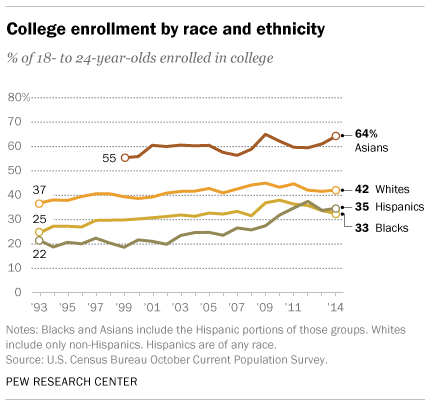
Also in the good news column, the University of California will continue to push for a greater number of underrepresented minorities; namely, Chicano/Latino students whose resident freshmen numbers rose from 2.7% to 32.3% of admitted California freshmen. In other good news, the proportion of Chicano/Latino students transferring from community colleges increased to 29.3% from 26.8% for 2015.
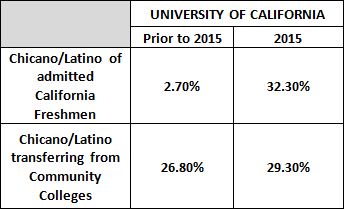
Occupations, including those in management, business, science, and art, fared better for Mexican Americans. The number of Mexican Americans filling these occupations rose from 17.4% in 2014 to 17.5% in 2015.

The total number of Hispanics filling these occupations was 16.1% in 2015, a bit lower than Mexican Americans specifically.
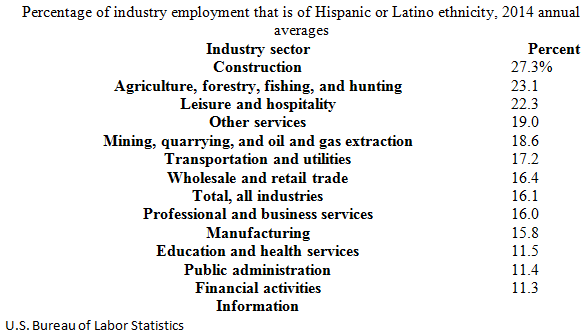
The report shows that industrial employment for Mexican Americans remained the same for 2014 and 2015 at 10.2%.
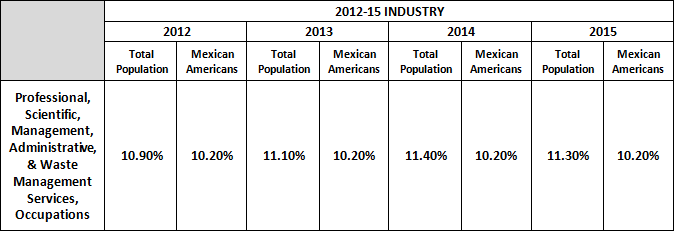
The figures for Hispanic or Latino employment for 2015 and 2016 show a healthy increase.
According to the Pew Hispanic center, “Construction, professional and business services, health services, financial services and food services…showed healthy gains.” Most of the jobs gained by native-born Hispanic workers were in manufacturing, mostly durable goods (82,000 Hispanic workers in this industry), followed by wholesale and retail trade (79,000), publishing, broadcasting, communication and information services (55,000), and construction (54,000).
Foreign-born Hispanics had the most job gains in construction (417,000), followed by business and professional services (179,000). Together, those two industries accounted for almost three-quarters (74%) of all jobs gained by foreign-born Latinos between 2005 and 2006.
The business and professional services sector, which ranges from management and technical services to janitorial, landscaping, and waste management services, is also a key employer for non-Hispanic workers. Of the total increase in employment in 2005-06, non-Hispanic workers accounted for 410,000 employees in the industry, native-born workers 327,000, and foreign-born workers 83,000.
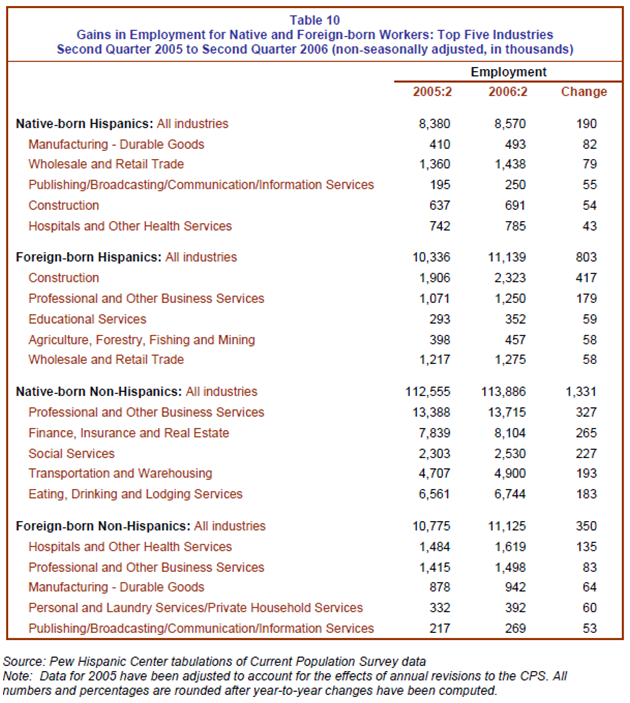
Sources
- Census Bureau, Selected Population Profile in the United States: 2015
- Pew Research Center
- University of California
- Bureau of Labor Statistics
A Latino Angel Wants To Help You Invest In Tech Startups
For the past two decades, I have been an advisor to many technology startups, and I can tell you this: raising the first million is the hardest.
Even harder: raising the first million if you are Latino/Latina founder.
Last week, DreamFunded – a San Francisco-based company that I’ve written about before — became the first SF-headquartered firm to get approval from FINRA to launch a portal that will enable many people — not just the rich — to invest in technology through crowdfunding. According to DreamFunded, it’s also the first Latino-led equity crowdfunding portal anywhere to get FINRA approval…
Link to article
John G. Florez Chemical engineering has taken this ACS Scholar around the world to encourage others to take up STEM education
A Scott – 2015
… An additional role he has taken on during his years at ExxonMobil has been to encourage other
Mexican Americans to establish a scientific career. … Mexican Americans continue to be poorly
represented in STEM subjects at the university level, Florez says. ..
Link to article
Looking to hire Hispanic STEM graduates? FIU a top producer of science and engineering talent
FIU graduates more Hispanics with bachelor’s and master’s degrees in science, technology, engineering and math (STEM) than any other university in the continental U.S., according to a report released today by Excelencia in Education.
Finding Your Workforce: Latinos in Science, Technology, Engineering, and Math (STEM), identifies institutions that graduate large numbers of Hispanics with STEM degrees in hopes of encouraging employers to engage with these institutions and hire graduates. FIU ranked second only to universities in Puerto Rico in graduating Hispanics with bachelor’s and master’s degrees…
Link to article
Mexican Engineer designs robots for NASA
LOS ANGELES – Mexican-born engineer Luis Velasco works at NASA on the digital design of robots visualized in 3D images before they are built, and he will provide his expertise to the Mars 2020 automatic rover…
Link to article
Finalists revealed: VL Innovators Challenge
Latinos use digital media more than any other ethnic group. But few Latinos are translating their tech savvy into tech work. In fact, only 7% of technology workers are Hispanic. Voto Latino believes Latinos can use their tech savviness to open doors to amazing careers in Science, Engineering, Technology and Math (STEM).
The VL Innovators Challenge was created to get millennials, especially Latino millennials, thinking about technology both as an innovative change agent and as a potential career. Applicants were encouraged to “use a tech tool to address a need in the Latino community.”
The Challenge will award $500,000 in grants to the best proposed projects. Winners will also spend two days on the Google campus in California where they will be paired with members of Google’s Marketing, Creative Labs, and Android teams, among others. Besides the chance…
Link to article
Tech Program Helps Put Latinos On A Path To Silicon Valley
About an hour south of Silicon Valley in a classroom at Hartnell Community College, Daniel Diaz and Brian De Anda stand at a whiteboard mapping out ideas on how to reduce the size of a mobile app their team is building.
This isn’t a class, and the app they’re building — an informational guide for a drug rehab center — isn’t even a school project. But this is what it takes to have a chance at an elite summer internship, says Daniel Diaz.
“What you are taught at school is not enough,” Diaz says, “especially in today’s competitive society. I think you need to do some more outside learning.”The inaugural class of the Computer Science and Information Technology program, scheduled to graduate in 2016.All Tech ConsideredOut Of The Fields And Into Computer Science Classes
So these students are working on other apps, doing hackathons and learning additional programming languages outside of class. They’re doing it because there’s a thought — perhaps a reality — that hangs over…
Link to article
Lessons to be learned from Latinos with dream jobs in tech
For millennials, jobs in the highest reaches of tech are among the most coveted. For Latino millennials, they sometimes seem unobtainable.
The numbers don’t lie. At Google, Twitter, and Facebook, Latino employees make up between 2 percent and 3 percent of their respective workforce. These abysmal numbers are standard also throughout Silicon Valley, where overall only 3 percent of workers are Latino…
Link to article
Mexican professionals bringing ambition, startups to North Texas
Dallas Morning News
A cocktail mixer sponsored by the Association of Mexican Entrepreneurs …. “Americans respect power, and that’s what we’re striving for, economic …
Link to article


